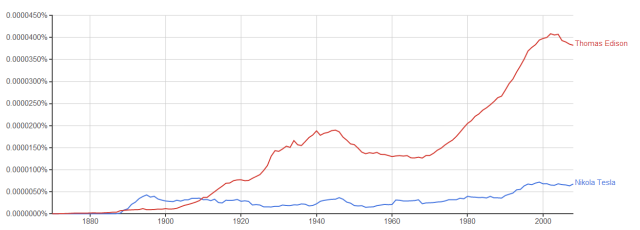Review of Tesla: Man out of time by Margaret Cheney
If you know anything about the history of electricity, then you have heard about Thomas Edison… but somehow, the other great inventor of the time, Nicola Tesla, seems to have been pushed from the public’s attention. I myself knew little about Tesla until The Oatmeal made a push to increase awareness of his many accomplishments.
I chose to read this biography partially because I wanted to learn how someone so revolutionary could be forgotten so summarily. Unfortunately, this issue is only mentioned, and never fully explored.
The first chapter is a vivid imagining of what it would have been like to visit Tesla’s laboratory at the height of his prominence. The next five chronicle his childhood and early career, his genius and neuroses, his early setbacks and his greatest achievement. This first part of the book is definitely the most interesting.
The problem in later chapters is that there is no cohesive story, but rather a series of more or less unrelated events. This isn’t the authors fault; Tesla was just making discoveries in every field. First he was wowing crowds with his discovery of halogen light bulbs (decades before they caught on), and another curious kind of light, which was later discovered to be x-rays. Then he discovered that the night sky was full of radio signals coming from far away (making him one of the fathers of radio astronomy). He also developed the first radio transmitter and later, the first remote controlled vehicle. He discovered that super cooled gases behave differently, thereby creating the field of cryogenics. He also built a system to transfer electrical power wirelessly. All this he did between 1983 and 1900. He lived until 1943 and was pretty busy the whole time.
One downfall on the author’s part is her poor description of Tesla’s experiments and inventions. Readers’ eyes will glaze over if they are interested only in Tesla’s eccentric personality and they will only be left wanting if they are genuinely interested in the science. For example, this is how a device called a carbon-button lamp is described:
It was a small glass globe with a tiny piece of solid material mounted of the end of a wire serving as single-wire connection with the high frequency current source. The central “button” of material electrostatically propelled the surrounding gas molecules towards the glass globe. They then were repelled back toward the button, striking it and heating it to incandescence as the process occurred millions of times each second.
I have no idea how to even visualize this, nor can I imagine how wondrous it might have been to see. It sounds like a fancy light bulb, but it turns out that the carbon-button lamp was an early version of the Electron Microscope. Of course right, who wouldn’t think of that? Later chapters go on to assume the reader will be familiar with concepts like electromagnetism and circuitry.
Nikola Tesla was an extremely gifted inventor, however he made a lot of mistakes during his career and those missteps cost him dearly. Both in gain during his lifetime as well as the legacy after his death. He is absolutely someone who should be known and thought about by those following in his footsteps. I would recommend that anyone who is interested in the great pioneering inventors of the turn of the twentieth century take the time to read Tesla: Man Out of Time.

